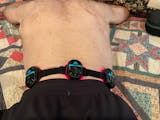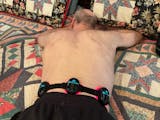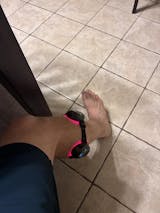Knee pain is a common issue that many people face, and it can have a significant impact on your quality of life. Whether it's caused by an injury, overuse, or the natural aging process, understanding what "the knee thing" is can help you find the right treatment. In this article, we’ll explore common knee issues, symptoms, causes, and effective treatments like
medical-grade red light therapy devices to manage knee pain and improve overall knee health.
Understanding Common Knee Issues
Knee problems are often associated with joint pain, swelling, or instability. Knowing what’s going on in the knee joint is crucial to finding effective treatment. Below are some common knee issues that people experience.
Osteoarthritis and Its Impact
Osteoarthritis is one of the most common knee issues, especially as we age. This degenerative condition occurs when the cartilage that cushions the knee joint breaks down, leading to pain, stiffness, and swelling. Over time, it can affect mobility, making everyday tasks like walking or climbing stairs difficult.
Tendonitis and Tendon Tears
Tendonitis happens when the tendons around the knee become inflamed, usually due to overuse or injury. This condition is common in athletes, especially runners. Tendon tears, on the other hand, can occur suddenly and may cause sharp pain and limited movement. Both conditions can benefit from treatments like physical therapy and fda cleared red light therapy devices.
Ligament Injuries (ACL, MCL)
Injuries to the knee’s ligaments, such as the ACL or MCL, are common in sports. These injuries often cause pain, instability, and difficulty moving the knee. Recovery from ligament injuries can be long, and in some cases, surgery is necessary. However, non-invasive treatments like red light therapy panel can support recovery and reduce inflammation.
Bursitis and Fluid Buildup
Bursitis occurs when the small fluid-filled sacs (bursae) around the knee become inflamed, often from repetitive motion. This leads to swelling, discomfort, and difficulty moving the knee. Reducing inflammation through rest, ice, and medical-grade red light therapy devices can help ease the pain and promote faster recovery.
Symptoms of Knee Problems
Recognizing the symptoms of knee issues early can help prevent further damage. Here are the most common signs that something might be wrong with your knee.
Swelling and Inflammation
Swelling is one of the first signs that something’s wrong with the knee. Whether it’s from an injury or a condition like arthritis, inflammation causes the knee to feel puffy and tight. Applying ice and using
red light therapy devices can help reduce swelling and promote faster healing.
Pain and Tenderness
Knee pain can vary from mild to severe. It may be constant or may worsen with activity. Tenderness around the knee joint or a sharp pain during movement could signal tendonitis, arthritis, or ligament injury. Red light therapy mask can target these painful areas to alleviate discomfort and promote healing.
Limited Range of Motion
If your knee feels stiff or you’re unable to fully bend or straighten it, you may have an issue with the joint’s flexibility. This could be a result of muscle weakness, swelling, or damage to the ligaments or cartilage. Stretching and strengthening exercises, along with red light therapy devices for home use, can improve your knee’s range of motion.
Instability and Giving Way
When your knee feels unstable or “gives way” under weight, it could indicate a ligament tear or severe tendon injury. This feeling of instability may occur suddenly and can make walking or climbing stairs difficult. In such cases, a proper diagnosis and treatment plan are necessary.
Causes of Knee Pain and Injury
Several factors can contribute to knee pain, from lifestyle choices to physical injuries. Knowing these causes can help you take steps to prevent or treat knee problems.
Overuse and Repetitive Motion
Knee injuries often occur when the joint is overused, especially in athletes. Repetitive activities like running, jumping, or cycling put stress on the knee, leading to conditions like tendonitis or bursitis. Taking regular breaks, stretching, and using medical-grade red light therapy devices can reduce the risk of overuse injuries.
Acute Injuries from Trauma or Fall
An accident or fall can cause immediate damage to the knee, such as fractures, sprains, or ligament tears. In these cases, immediate medical attention is needed, but treatments like red light therapy panel can help with the recovery process by reducing pain and inflammation.
Age and Degenerative Conditions
As we get older, our cartilage wears down, and knee joints naturally become more prone to arthritis and other degenerative conditions. While age is a factor, maintaining a healthy weight and staying active can help reduce the wear and tear on your knees. Red light therapy mask can help mitigate some of the discomfort associated with aging knees.
Obesity and Joint Stress
Carrying excess weight places added stress on the knees, which can lead to conditions like osteoarthritis. By managing your weight through proper diet and exercise, you can reduce the load on your knee joints. Regular use of medical-grade red light therapy devices can also help ease joint pain and inflammation caused by excess weight.
Treatment Options for Knee Issues
There are many treatment options available for knee problems, ranging from self-care to medical interventions. Let's explore the most common treatments.
Physical Therapy and Exercise
Physical therapy focuses on strengthening the muscles around the knee and improving flexibility. Targeted exercises help improve knee function and reduce pain. In addition,
medical-grade red light therapy devices - PRUNGO FluxGo can enhance recovery by reducing inflammation and speeding up tissue repair.
Medications and Injections
For pain relief, over-the-counter medications like NSAIDs can help reduce inflammation. In some cases, doctors may recommend corticosteroid injections to manage severe knee pain. Using
red light therapy panel alongside medication can provide a more comprehensive approach to managing knee discomfort.
Surgical Options for Severe Cases
If conservative treatments don’t provide relief, surgery may be necessary. Procedures like knee replacement or ligament repair can restore knee function. Post-surgery, fda cleared red light therapy devices can accelerate healing and improve the recovery process by promoting tissue regeneration and reducing pain.
How Medical-Grade Red Light Therapy Devices Can Help
Red light therapy is gaining recognition as an effective treatment for knee pain. Here’s how medical-grade red light therapy devices can benefit those with knee issues.
How Red Light Therapy Works
Red light therapy uses specific wavelengths of light to penetrate the skin and stimulate healing at the cellular level. This therapy increases blood flow, reduces inflammation, and promotes tissue repair. For knee issues, red light therapy panel can target deep tissues to reduce pain and swelling.
Benefits for Pain and Inflammation
One of the primary benefits of
fda approved red light therapy is its ability to reduce pain and inflammation. By promoting circulation and easing muscle tension,
red light therapy mask can help ease discomfort, especially in chronic conditions like arthritis or tendonitis.
Post-Injury Recovery with Red Light Therapy
For people recovering from knee injuries, red light therapy can speed up recovery by stimulating tissue regeneration. Regular sessions with red light therapy devices help heal damaged tissues faster, so you can return to your normal activities sooner.
Non-invasive Alternative to Surgery
For those who prefer non-invasive treatments, red light therapy provides an effective alternative to surgery. It’s a safe, drug-free option that can be used at home or in a clinical setting to relieve pain and promote healing in the knee joint.
When to Seek Medical Attention for Knee Pain
Knowing when to seek medical help can prevent knee problems from getting worse. If you experience any of these symptoms, it’s time to see a doctor.
Persistent or Worsening Pain
If knee pain persists for more than a few days or worsens over time, it’s important to seek professional help. A healthcare provider can identify the underlying cause and recommend an appropriate treatment plan.
Difficulty Walking or Bearing Weight
If you’re unable to walk properly or bear weight on your knee, it may indicate a serious injury, like a torn ligament or cartilage damage. Medical intervention is necessary to prevent further damage and begin the recovery process.
Swelling and Redness
Swelling and redness that doesn’t go away with home care may indicate an infection or more severe injury. Consulting a doctor will help determine the best course of action for treatment.
Conclusion
Knee pain can be caused by a variety of factors, ranging from injury to degenerative diseases. Whether it's overuse, aging, or trauma, understanding the condition of your knee is the first step in finding the right treatment. Medical-grade red light therapy devices offer a promising non-invasive solution to reduce pain and promote healing. red light therapy panels are ideal for treatments requiring large-area irradiation; and if your goal is facial care, red light therapy masks can act on multiple areas of the face simultaneously, particularly helpful for anti-aging, relaxing and repairing the skin, and reducing fine lines.


























0 comments